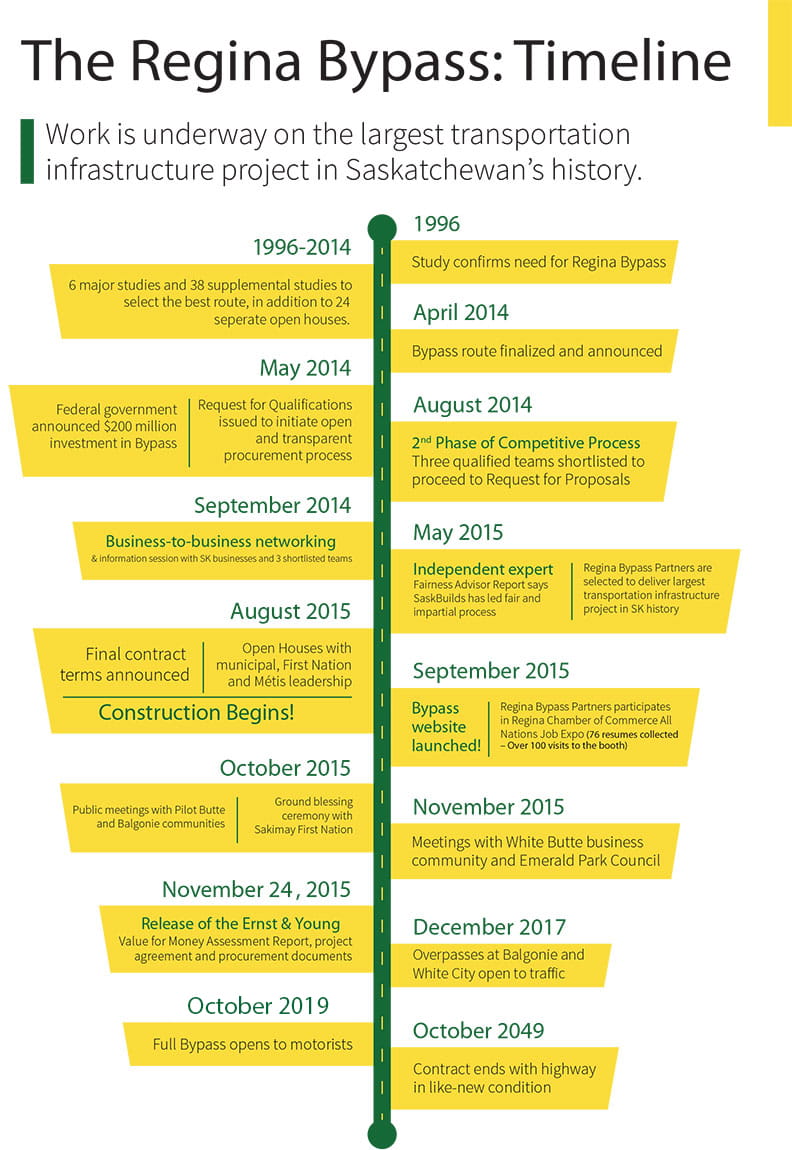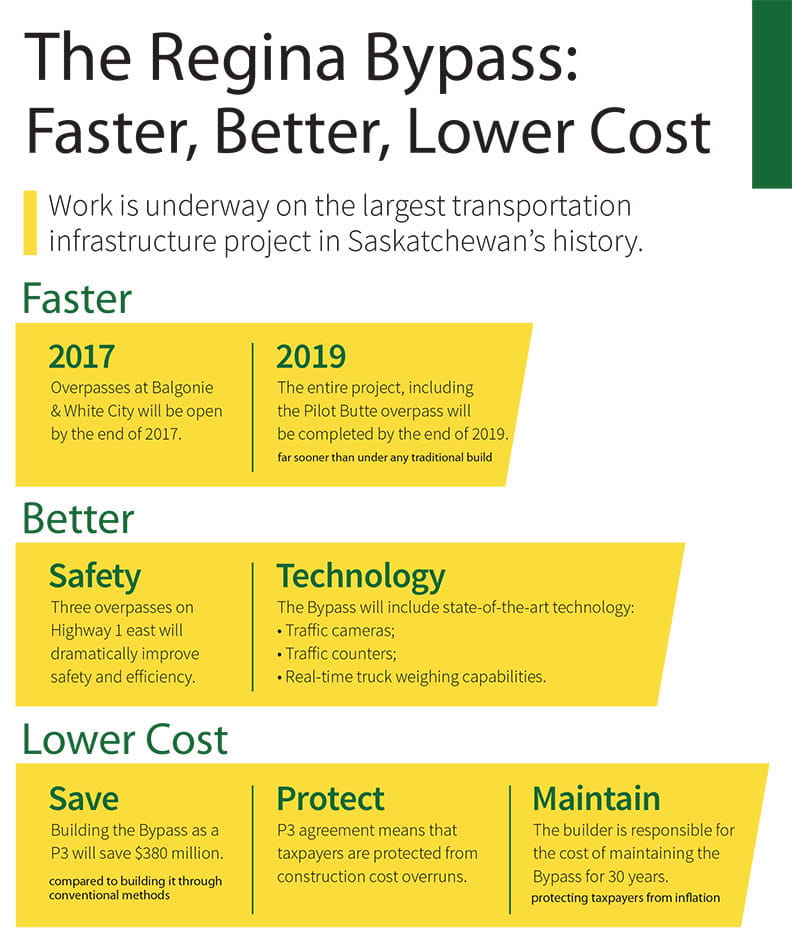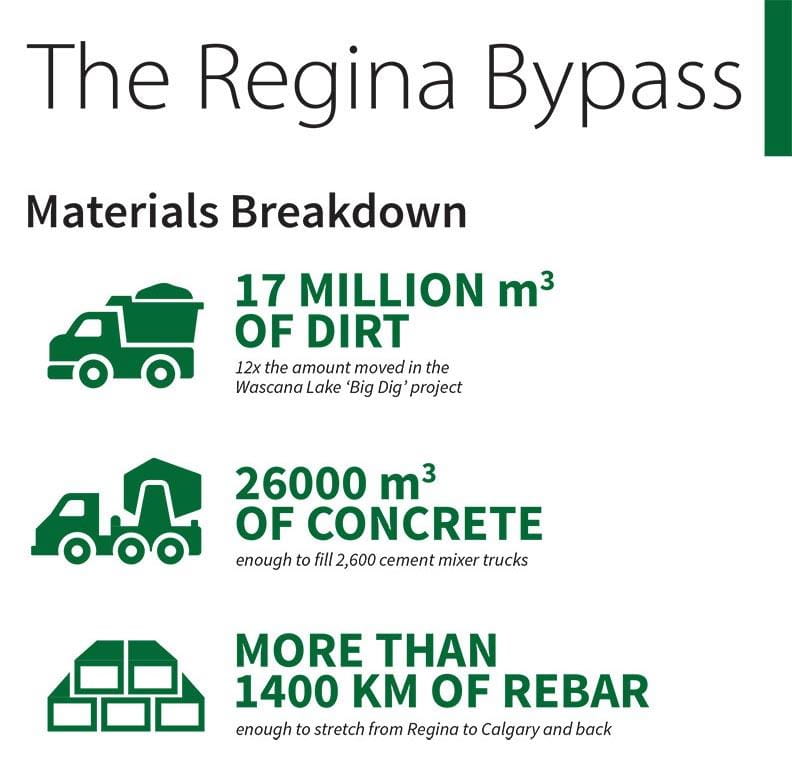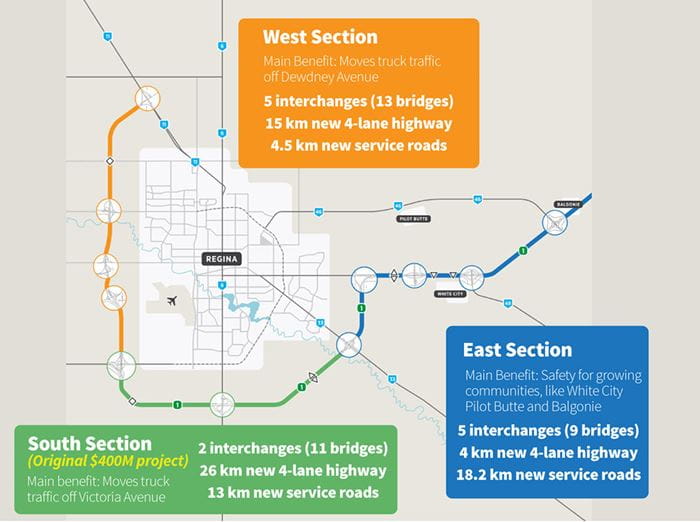Regina Bypass Project
The Regina Bypass is the largest infrastructure project in the province's history. Below is a series of four, 3-D flyover videos of the project's conceptual design.
1. How was the route selected?
The need for a bypass was identified in the 1990s. Since then, six major studies and 38 supplemental studies have been undertaken. These studies concluded the selected route is the best choice now and into the future.
Public and stakeholder consultation was a priority throughout the study process.
The route selected received approval from the City of Regina, Balgonie, White City, Pilot Butte, Emerald Park, Edenwold and the Rural Municipalities of Sherwood and Edenwold.
2. What are the project's timelines?
- Work on the project started on July 29, 2017.
- Overpasses at White City and Balgonie opened in 2017.
- The project was complete on October 28, 2019.
- The Regina Bypass opened to the public on October 29, 2019.

3. Why was the Bypass built?
The Regina Bypass:
- Improves driver safety.
- Improves a key component of the National Highway System.
- Reduces traffic congestion in and around Regina.
- Increases efficiency for truckers and shippers moving goods.

4. What did the Bypass project include?
To address critical safety concerns, the project included overpasses at:
- Pilot Butte Access Road;
- Highway 48 at White City; and
- Highway 46 at Balgonie.
In total, the project consisted of approximately:
- 12 overpasses;
- 40 kilometres of new four-lane highway;
- 20 kilometres of resurfaced four-lane highway;
- 55 kilometres of new service roads; and
- Twinning of about five kilometres of Highway 6.

5. Project Team
- Regina Bypass Design Builders awarded the contract to a team comprised of:
- Buckland and Taylor
- Carmacks
- Clifton Assoc.
- Delcan
- Exp
- GraCorp Capital
- Graham Construction (lead builder)
- McElhanney
- National Bank
- Parsons
- Urban System
- VINCI
- 9,200 jobs were also created in Saskatchewan for this project.
6. Public-Private Partnership (P3)
- The Regina Bypass was built as Public-Private Partnership (P3).
- With a P3, the team that builds the bypass must maintain it in "like new" condition for 30 years. This encourages the use of high-quality materials and long-term thinking in design to reduce costs into the future.
- Unlike many government projects throughout history, P3s finish on-time and on-budget.
- A P3 model had the project completed at least six years faster than a traditional build.
Operations and maintenance
In addition to construction cost, the builder is also responsible for operation, maintenance and transfer of risk.
Operation and maintenance includes but is not limited to:
- Repaving Highway 1 east of Regina to Balgonie;
- Surface repair;
- Pavement marking;
- Repairing and replacing signs;
- Bridge/culvert repair;
- Ditch mowing, snow clearing, weed control, garbage pickup;
- Drainage control;
- Lighting and power costs;
- Acquisition of equipment, facility and staff.
In addition, at the end of the contract, the government will receive all infrastructure in "like new" condition.
Transfer of risk: taxpayers are protected from any project cost overruns. These costs will be incurred by the builder.
7. Project Cost
Why did the scope and cost of the Regina Bypass project change?
The first concept of the Regina Bypass was in 2013. This was for the south section, to divert truck traffic off Victoria Avenue East. The cost estimate was roughly $400 million.
There were two other projects also being considered around Regina:
Project one: overpasses east of ReginaGoal: provide greater safety to the growing communities in that area.
Cost: roughly $400 million.
Project two: overpasses west of Regina
Goal: divert traffic off Dewdney Avenue
Cost: roughly $400 million. A decision was made to combine these individual components into one project: the Regina Bypass.
So, the original $400 million estimate now increased to $1.2 billion as the project scope increased.

Another number often cited is $1.88 billion* for the Regina Bypass. That number is the total cost of the project. It includes construction and the transfer of risk to the private contractor. This includes 30 years of regular maintenance, reconstruction and snow removal.
Professional cost estimators calculated the cost of building and maintaining the bypass was $2.2 billion. The $1.88 billion* Graham-team P3 bid was less expensive so it was accepted.
Ernst & Young verified the P3 method will save Saskatchewan people $380 million.
Saskatchewan business groups have endorsed P3s as a way to improve infrastructure and create jobs. This includes:
- The Saskatchewan Chamber of Commerce
- The Saskatoon Chamber of Commerce
- The Regina Chamber of Commerce
- The Swift Current Chamber of Commerce
- The North Saskatoon Business Association
*Note: land acquisition is separate from this cost and is projected at roughly $100 million.
8. Further Information
Regina Bypass Project – Outstanding Work, as of October 31, 2019
Additional information about the project can be found on the Regina Bypass website.
